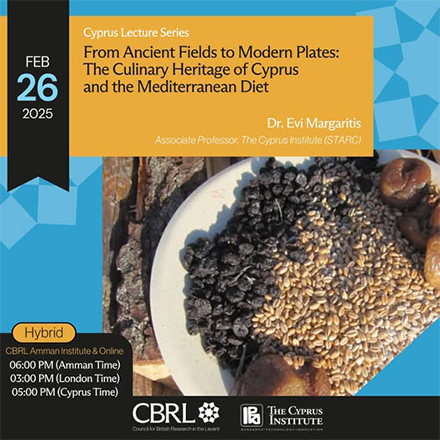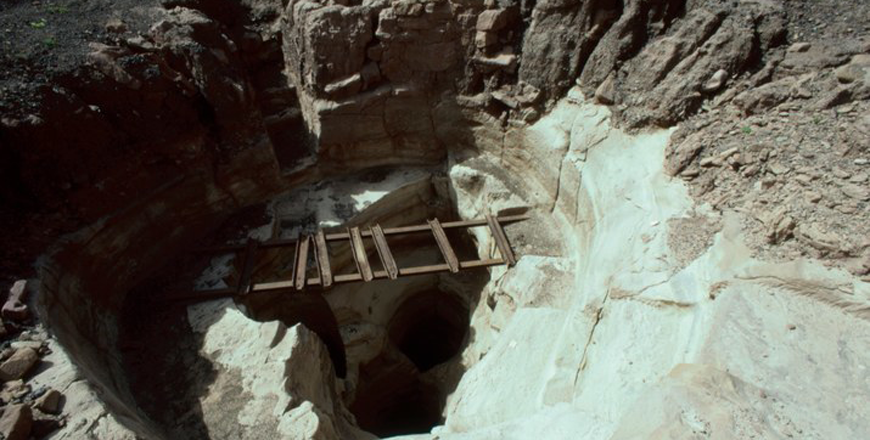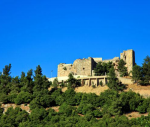You are here
Cyprus lecture explores Mediterranean culinary heritage, diet’s evolution
By Saeb Rawashdeh - Feb 28,2025 - Last updated at Mar 01,2025

AMMAN — As a part of its Cyprus lecture series, the Council for British Research in the Levant organised a presentation on Wednesday under a title “From Ancient Fields to Modern Plates: The Culinary Heritage of Cyprus and the Mediterranean Diet”.
“We do not focus on the properties of plants but the observations are based on anthropology, sociology and history,” said Associate Professor at the Science and Technology in Archaeology and Culture Research Centre of the Cyprus Institute Evi Margaritis.
Margaritis noted that focus of her lecture is on the role of food as a medium of communication-enhancing social relations and distinguish between those who belong or are excluded from the group (communal cooking and eating).
During history Cyprus has been one of the hubs of the Mediterranean diet and food was preserved in carbonised.
Margaritis’ academic interests are environmental archaeology and palaeoeconomy, since she specialised Archaeobotany at the University of Sheffield with a PhD from the University of Cambridge. She tried to connect a Bronze Age Mediterranean diet with more contemporary Cypriot cuisine by analysing seeds, starches, phytoliths and wood.
“High values of the xerophytic wood/shrubare also recorded whereas the desert and warmly mixed forest biomes display the lowest scores,” the professor explained, adding that the evidence suggests that due to a dry environment agricultural activity was very low at the site of Pyla dating to the end of the Bronze Age
Regarding farm animals, the domesticated cow was introduced to Cyprus sometime during the early Neolithic period, but it “inexplicably disappeared from Cyprus shortly afterward its initial arrival and was not re-introduced to the island until the beginning of the Bronze Age”, Margaritis said.
The professor said that as a farm animal, the cow provides both traction power for ploughing and a source of ample manure.
“These aspects of the cow allow for the farming of less fertile land and facilitate agricultural extensification — the growing of crops with minimum input and maximum output,” Margaritis underlined.
The absence of the cow in Cyprus seems to have delayed the transition from small-scale intensive farming to large-scale agricultural regimes on this island, according to the professor, and cows reintroduction at the start of the Bronze Age can be viewed as the beginning of a major shift in farming practices on Cyprus
“The possibility of plough agriculture and the additional source of manure allowed settlements to occupy less fertile land located closer to the island’s copper resources,” Margaritis said.
This change in the island’s settlement pattern, however, did not occur until the later Bronze Age, possibly due to a period of agricultural experimentation with the cow before moving to areas of higher-risk farming,” the professor elaborated.
Regarding commodity products in the Bronze Age Cyprus such as wine and olive oil, value was added in the transformation of these crops into dried fruits, oil, wine etc. To increase their longevity while reducing their bulk, these goods became a matter of prestige.
“New basis for manufactured food commodities for exchange to be routed through cities, accompanying the general increase in trade of specialised craft items. This development can be seen as parallel and comparable with the specialisation of animal secondary products such as wool, milk and animal traction,” Margaritis underlined.
To bring the past to the future, her team with doctoral students revisited and recorded the tangible rural heritage; safeguarded the living intangible heritage; protected the biodiversity; and asked the right questions from the past for a sustainable future.
“The Mediterranean diet is widely regarded as among the most nutritionally balanced and sustainable in the world.
The origins of the Mediterranean dietary pattern, based on an abundance of plant foods [including olive oil as the main source of fat], low animal fat intake and moderate wine consumption, are often placed in the Middle Ages or, at most, Antiquity, but its roots can actually be traced back to prehistoric times,” Margaritis elaborated.
The presence of the Mediterranean triad (wheat, olive and grape) has been attested in the Bronze Age archaeological record across the Mediterranean, and recent evidence suggests that wine-making started during the Neolithic.
Similarly, evidence for olive oil production dates back to the mid-5th mil. BC, the preparation of bulgur and trachanas (traditional cereal-based foods from south-eastern Europe) has been documented in Bulgaria in the early 6th mil. BC, and bread-making has been attested in the Levant as early as 14,400 years ago, Margaritis highlighted
“Vegetables, herbs, and spices have been used in the Eastern Mediterranean for over three thousand years, with archaeobotanical evidence dating back to both Classical and prehistoric times. Archaeological findings suggest that key elements of the Mediterranean diet, such as low animal fat intake and a reliance on plants, were already present during the Bronze Age or even the Neolithic. However, in recent decades, Mediterranean countries have seen a shift away from traditional diets, leading to increased obesity and health issues. Margaritis emphasised that archaeological data can help us understand how these culinary traditions survived and promote the Mediterranean diet today among various stakeholders.
Related Articles
AMMAN — During the Late Bronze Age, economic interconnectedness characterised relations between Egyptian dynasties, Hittite state and
AMMAN — An archaeological team has discovered three ancient settlements in Mafraq’s Safawi area, the Jordan News Agency, Petra, reported on
PARIS — A health study came to the defence of certain dietary fats on Tuesday, adding fuel to a scientific row over low-fat guidelines that


















